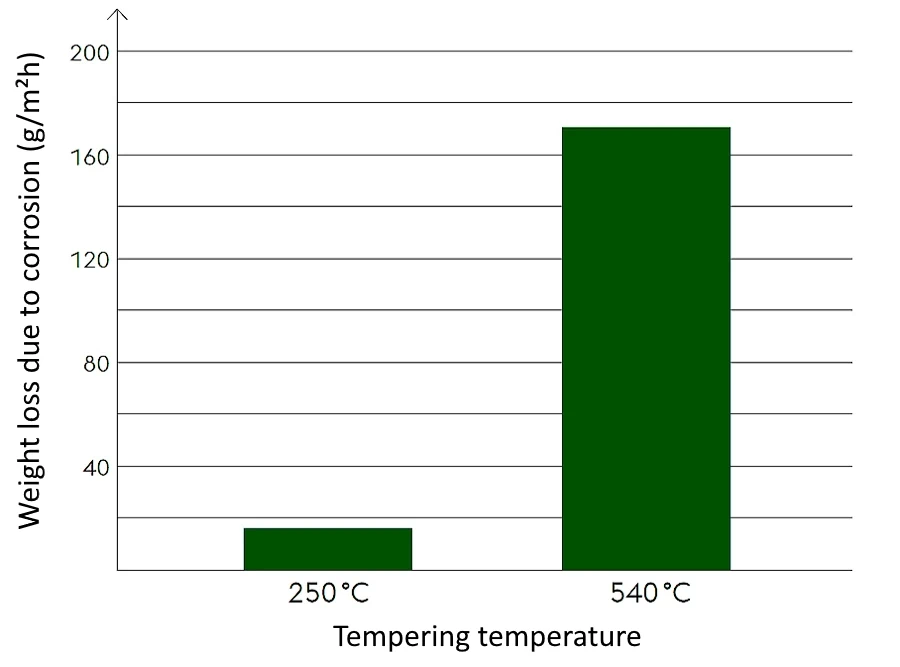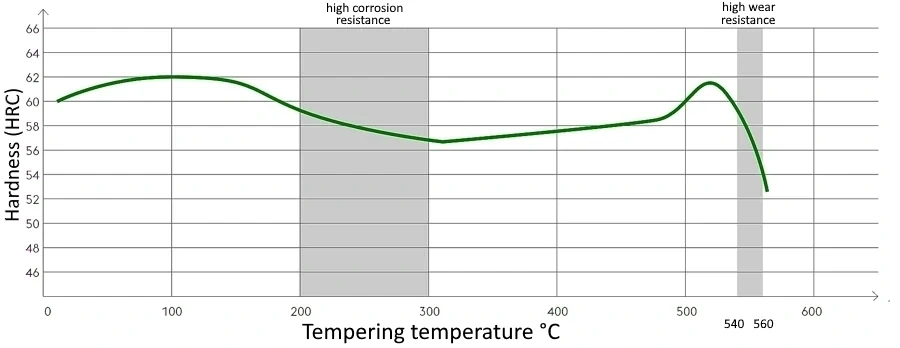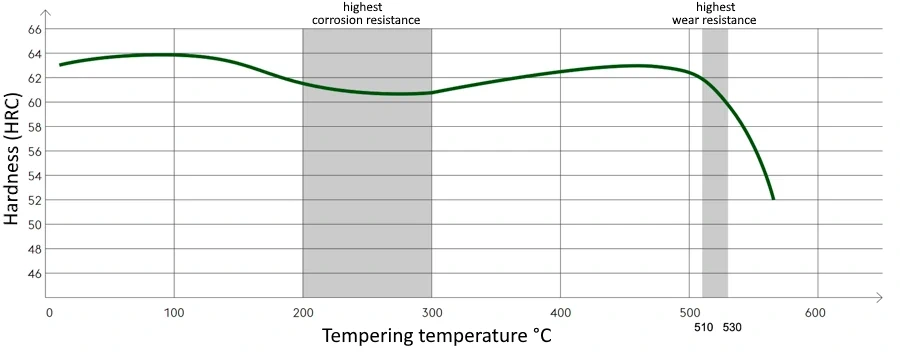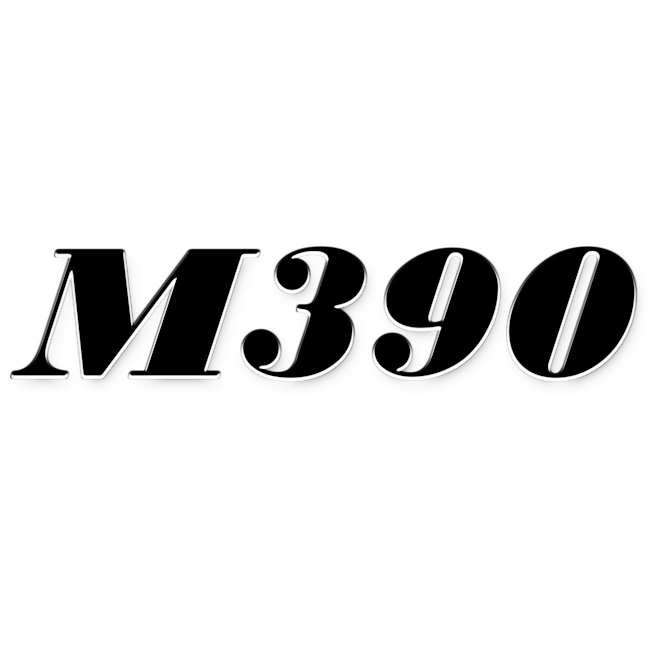M390 is a powder stainless martensitic steel with increased chromium content. Böhler M390 is one of the best knife steels in the world. This product of modern powder metallurgy from the Böhler-Uddeholm concern perfectly combines wear resistance, corrosion resistance, high strength and high impact toughness.
Due to the high content of vanadium and chromium in the microstructure of the steel, a significant concentration of their carbides is observed, and the 3rd generation powder remelting technology (Microclean®) allows for a homogeneous and finely dispersed structure to be obtained.
Thanks to its alloying concept, this steel offers extremely high wear resistance and high corrosion resistance - the ideal combination for the best application properties.
The Böhler M390 is manufactured by Böhler Edelstahl GmbH & Co KG in Kapfenberg, Austria. This manufacturer produces steel types that are incredibly resistant to wear and tear. So-called "special steels". This may come as a surprise, but almost all the steel types we know today were not developed as leg steel. Many types/kinds of steel were developed for ball bearings or parts in jet engines. The same goes for the Böhler M 390.
Although Böhler M390 is one of the most popular and best steels on the market, Böhler developed it for use in die-casting molds. If you look at Böhler's datasheet, this is listed as the primary purpose. The fact that it is well suited for use in knives is considered an alternate purpose.
For these molds, the steel also needs to be very wear-resistant. If you want to be able to pull the same mold out of the same mold about 10,000 times, it shouldn't wear out between the first casting and the 10,000th. That's why these molds are made from high-quality steel grades.
It is therefore not surprising that M390 is used as a mould steel. After all, the industrial market is much larger. Böhler can sell many more kilograms of steel to this industry than the knife industry consumes, where we are talking about relatively small and light steel sheets.
Properties
The steel is usually supplied in a soft annealed condition with a maximum hardness of 280 HB. Optimum soft annealing is only possible after hot stamping.
- Strength and ductility: good.
- Wear resistance: very high.
- Machinability: good.
- Dimensional stability is very high.
- Polishability: very high.
- Corrosion resistance: good.
- Microcleanliness: very high.
M390 is so wear-resistant that it also holds the shape of the knife blade properly. So a knife made from M390 steel will stay sharp for a very long time. This means that you won’t have to sharpen your knife as often. This is not only great because sharpening your knife takes time, but it also means that your knife will last longer. After all, the more often you sharpen your knife, the faster it wears out. It’s impossible to sharpen the entire blade: the blade will become too thick beyond the edge. This means that it’s not as easy to use.
Application
- Components for the food and animal feed industry;
- Machine scissors / knives;
- Food industry;
- Plastic extrusion;
- Glass fiber reinforced plastics;
- Injection molding;
- Custom manufacturing of hand knives;
- Medical;
- Powder pressing;
- Screws and barrels;
- Electronic industry;
- Packaging;
- Tablet punches.
Chemical composition
Chemical composition of steel grade M390 | |||||||
| C | Cr | Mo | W | V | Mn | Si | Fe |
| 1,9 | 20,0 | 1,0 | 0,6 | 4,0 | 0,3 | 0,7 | Other |
M390 is made using a powder metallurgy process. This requires some explanation. Typically, a manufacturer combines various elements in an alloy, pours large blocks, and flattens them to produce sheets that can be used by knife makers. However, Böhler takes it a step further. After combining these elements, they put it in a gas atomizing machine, which sprays molten steel as a kind of diffuser. The result is a structure that is much finer on a molecular level.
Corrosion resistance
For maximum corrosion resistance, use lower tempering temperatures. Heat treatment: austenitizing at 1150 °C / 20 min. / 5 bar, without cooling below zero. Weight loss test: measured after 24 hours with 20% boiling acetic acid.

Heat treatment
Heat treatment of steel M390 | ||
| Stress relievin | ||
| Temperature | max. 650 °C | Soft annealed material: for stress relief annealing after mechanical processing, hold the material at temperature in a neutral atmosphere for 1-2 hours after complete heating, then slowly cool the furnace at 20 °C [68 °F]/hour to 200 °C [392 °F], then cool in air. |
| Temperature | Hardened and tempered material: the temperature for stress relief annealing should be approx. 50 °C [122 °F] below the previously selected tempering temperature. Other procedure as for stress relief annealing of soft annealed material. | |
| Hardening and Tempering | ||
| Temperature | 1,100 to 1,150 °C | For hardening, hold the material at the specified temperature for 20-30 minutes after complete heating and quench quickly. Cool the material to approx. 30 °C [86 °F]. Immediately afterwards, the material can be deep-frozen for 2 hours (at -80 °C [-112 °F]) for residual austenite transformation. Tempering should also be carried out immediately. |
| Temperature | 1,151 to 1,180 °C | For hardening, hold the material at the specified temperature for 5-10 minutes after complete heating and quench quickly. Cool the material to approx. 30 °C [86 °F]. Immediately afterwards, the material can be deep-frozen for 2 hours (at -80 °C [-112 °F]) for residual austenite transformation. Tempering should also be carried out immediately. |
| Temperature | 200 to 300 °C | Tempering treatment: for maximum corrosion resistance, heat the material slowly and temper once for 1 hour/20 mm material thickness, but for at least 2 hours. Take slow heating into account and cool the material to approx. 30 °C [86 °F] after each heat treatment step. |
| Temperature | 540 to 560 °C | Tempering treatment: for maximum wear resistance (without sub-zero cooling), temper the material 3 times for 1 hour/20 mm material thickness, but at least 2 hours. Allow for slow heating and cool the material to approx. 30 °C [86 °F] after each heat treatment step. |
| Temperature | 510 to 530 °C | Tempering treatment: for maximum wear resistance (with sub-zero cooling), temper the material 3 times for 1 hour/20 mm material thickness, but at least 2 hours. Allow for slow heating and cool the material to approx. 30 °C [86 °F] after each heat treatment step. |
It is sometimes said that the type of steel is the body, but the heat treatment determines the soul of the steel. There are different recipes for tempering the same type of steel. For example, it may be that M390 will not retain its sharpness as long for some manufacturers, but will be stronger and more resistant to corrosion. Or competitors introduce knives with extremely wear-resistant M390 that are more susceptible to rust. Are some better than others? It depends on the purpose. It is a choice. A stronger version will work better for more demanding tasks. A harder version will work better if you only need to pay attention to wear and sharpness.
Hardening without treatment at negative temperatures

- Vacuum hardening: 1150 °C / 30 min / N2, 5 bar.
- Tempering: 2 x 2 hours.
- Sample dimensions: diameter 20.5 x 15 mm.
Quenching with treatment at negative temperatures

- Vacuum hardening: 1150 °C / 30 min / N2, 5 bar.
- Processing at sub-zero temperatures: -70 °C, 2 hours.
- Tempering: 2 x 2 hours.
- Sample dimensions: diameter 20.5 x 15 mm.
Mechanical processing
Turning with sintered carbide
| Depth of cut mm (inch) | 0.5 - 2 (.02 - .04) | 1 - 4 (.04 - .16) | 4 - 8 (.16 - .31) | over 8 (over .31) |
| Feed mm/rev. (inch/rev.) | 0.1 - 0.3 (.004 - .012) | 0.2 - 0.4 (.008 - .016) | 0.3 - 0.8 (.012 - .031) | 0.5 - 1.5 (.020 - .060) |
| Cutting speed vc (m/min) (f.p.m) | 130 - 260 (425 - 850) | 100 - 220 (330 - 720) | 80 - 140 (260 - 460) | 30 - 90 (100 - 295) |
| Recommended BOEHLERIT-geometry | FP, FMP | MP, MRP | MRP | RP, BR, BRP |
| BOEHLERIT grade | LCP15T | LCP15T, LCP25T | LCP25T, LC240F | LC240F |
| ISO grade | P15 | P15, P20 | P20, P30 | P30, P40 |
Condition: soft annealed. The figures given are approximate.
Turning with high speed steel
| Depth of cut mm (inch) | 0.5 (.02) | 3 (.12) | 6 (.24) |
| Feed mm/rev. (inch/rev.) | 0.1 (.004) | 0.4 (.016) | 0.8 (.031) |
| BÖHLER-/DIN-grade | S700 / DIN S10-4-3-10 | ||
| Cutting speed vc (m/min) (f.p.m) Tool life 60 min. | 30 - 20 (100 - 65) | 20 - 15 (65 - 50) | 18 - 10 (60 - 35) |
| Rake angle | 14° | 14° | 14° |
| Clearance angle | 8° | 8° | 8° |
| Inclination angle | -4° | -4° | -4° |
Drilling with sintered carbide
| Drill diameter mm (inch) | 3 - 8 (.12 - .31) | 8 - 20 (.31 - .80) | 20 - 40 (.80 - 1.6) |
| Feed mm/rev. (inch/rev.) | 0.02 - 0.05 (.001 - .002) | 0.05 - 0.12 (.002 - .005) | 0.12 - 0.18 (.005 - .007 |
| BOEHLERIT/ISO-grade | HB10 / K10 | ||
| Cutting speed vc (m/min) (f.p.m) | 50 - 35 (165 - 115) | 50 - 35 (165 - 115) | 50 - 35 (165 - 115) |
| Point angle | 115° - 120° | 115° - 120° | 115° - 120° |
| Clearance angle | 5° | 5° | 5° |
Milling with sintered carbide
| Cutting speed vc (m/min) (f.p.m) | 160 - 230 (525 - 755) | 150 - 200 (490 - 655) | 120 - 170 (395 - 560) |
| BOEHLERIT grade | BCH10M, BCP25M | BCH30M, BCP35M | BCH30M, BCK20M |
| ISO grade | H10, P25 | H30, P35 | H30, K20 |
| Fz Milling 90° mm (inch) | 0.1 - 0.3 (.004 - .012) | 0.1 - 0.3 (.004 - .012) | 0.1 - 0.3 (.004 - .012) |
| Fz Milling 45° mm (inch) | 0.15 - 0.8 (.006 - .031) | 0.15 - 0.8 (.006 - .031) | 0.15 - 0.8 (.006 - .031) |
| Fz High feed cutting mm (inch) | 0.8 - 2.5 (.031 - .10) | 0.8 - 2.5 (.031 - .10) | 0.6 - 3.0 (.024 - .12) |
Milling with inserted tooth cutter
| Feed mm/tooth (inch/tooth) | up to 0.2 (.008) |
| Cutting speed vc (m/min) (f.p.m) | |
| BOEHLERIT SBF/ISO P25 | 120 - 60 (395 - 195) |
| BOEHLERIT SB40/ISO P40 | 70 - 45 (230 - 150) |
| BOEHLERIT ROYAL 635/ISO P35 | 80 - 60 (260 - 195) |
Physical properties (20 °C)
- Density (kg/dm³): 7.54
- Thermal conductivity (W/(m.K)): 16.5
- Specific heat (kJ/kg K): 0.48
- Spec. electrical resistance (Ohm.mm²/m): -
- Modulus of elasticity (10³N/mm²): 227
Thermal Expansions between 20 °C | 68 °F and ...
| Temperature (°C) | 100 | 200 | 300 | 400 | 500 |
| Thermal expansion (10⁻⁶ m/(m.K)) | 10,38 | 10,67 | 10,96 | 11,24 | 11,56 |
Advantages and disadvantages
Advantages of Böhler M390
In addition to sharpness retention, M390 has several other excellent qualities. It can be hardened to a relatively high hardness without breaking quickly. However, this does not mean that M390 is very tough. It does mean that M390, compared to other types of steel, can be sharpened a little finer.
M390 is also relatively rust-proof. Because of the high amount of chromium, rust doesn't stand a chance. Especially compared to other hard steels that are known for their ability to hold an edge, but can still be susceptible to rust.
Disadvantages of Böhler M390
Where there are advantages, there will be disadvantages. For example, M390 has a relatively high price. Wear resistance, in particular, also means that it is difficult to modify. So you need more time to modify it, but your grinding belts will also wear out much faster. Therefore, a knife made of M390 steel is often more expensive than another type of steel.
The M390 is also not that easy to sharpen. That is, you won’t get very far using a simple sharpening stone. The M390 prefers a diamond-coated stone or ceramic options. Preferably at a fixed angle. The M390 is also not very strong. It is not brittle either, and you need to take that into account.
Steel types that are very similar to Böhler M390 (analog)
Chemically, there are several steels that are very similar to M390. Take CPM 20CV and Carpenter CTS-204P, for example. The components and manufacturing process are similar. And if you take into account all the cutting tests that have been done, you can say that from a performance standpoint, they are similar too. Is one of these steels better than the other? No. The differences are so small that the consumer will never notice them.
